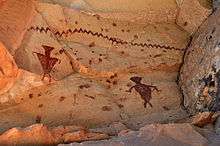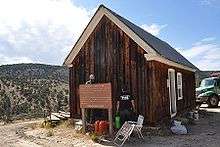Kanab Creek Wilderness
| Kanab Creek Wilderness | |
|---|---|
|
IUCN category Ib (wilderness area) | |
 | |
| Location | Coconino / Mohave counties, Arizona, United States |
| Nearest city | San Manuel, AZ |
| Coordinates | 36°33′55″N 112°34′08″W / 36.56528°N 112.56889°WCoordinates: 36°33′55″N 112°34′08″W / 36.56528°N 112.56889°W |
| Area | 75,300 acres (305 km2) |
| Established | 1984 |
| Governing body | Bureau of Land Management |


Kanab Creek Wilderness is a 75,300-acre (305 km2) wilderness area[1] located along the Coconino/Mohave County line in the U.S. state of Arizona, approximately 30 miles (48 km) south of Fredonia. 68,600 acres (278 km2) of the Wilderness are located in the North Kaibab Ranger District of the Kaibab National Forest, the remaining 6,700 acres (27 km2) are administered by the Arizona Bureau of Land Management.[2]
One of the major tributaries of the Colorado River, Kanab Creek is the largest tributary canyon system on the north side of the Grand Canyon. From its origin approximately 50 miles (80 km) north in southern Utah, Kanab Creek and its feeder streams have cut a network of gorges with vertical walls deep into the Kanab and Kaibab Plateaus. Elevations in the Wilderness range from 2,000 feet (610 m) at the river to about 6,000 feet (1,829 m) on the rim.[3]
Evidence in Kanab Creek Wilderness indicates that this area was inhabited by prehistoric peoples up to approximately AD 1100. The Wilderness contains some of the most interesting and significant rock art in the Southwest.[4]
Vegetation
Kanab Creek Wilderness is dominated by desert shrub blackbush, with occasional clumps of Indian ricegrass or needle-and-thread grass in the lower elevations. Along the drainage bottoms are groups of cottonwood, desert almond, western redbud, and single-leaf ash trees, though some of these riparian habitats are being invaded by salt cedar. The upper reaches have some stands of pinyon pine and juniper, but sagebrush dominates most of the area.[4]
Wildlife
The higher elevations of Kanab Creek Wilderness are used as winter range by mule deer and almost all of the chukar partridge in Arizona live in this area. The area is home to bobcat, fox, coyote, and various small mammals such as rabbit, squirrel, and mice. Several species of toad, frog, lizard, and snake can also be found in this area. The only known poisonous snake in the Wilderness is the rattlesnake.[4]
Trails

Three trails lead into Kanab Creek Wilderness:[6]
- Jumpup-Nail Trail or Trail #8 descends from Sowats Point, crosses Sowats Canyon, and descends into Jumpup Canyon where it joins Trail #41. This trail is 6 miles (9.7 km) long.
- Ranger Trail or Trail #41 descends into Jumpup Canyon for about four miles before exiting the canyon just above Lower Jumpup Spring. It then follows the general contour of a sandstone bench that encircles the Jumpup Point promontory before crossing Lawson, Dinner Pockets, and Big Cove Canyons and descends into Kanab Creek Canyon about 5 miles beyond Lawson. It ends in the canyon where it joins Trail #59. This trail is 17 miles (27.4 km) long.
- Snake Gulch-Kanab Creek Trail or Trail #59 joins the Ranger Trail in Kanab Creek Canyon about three miles downstream from the confluence with Snake Gulch. It then continues down the canyon but is not signed or maintained beyond that point. This trail is 21.5 miles (34.6 km) long.
See also
References
- ↑ "Kanab Creek Wilderness" USDA Forest Service. Retrieved 2015-08-19.
- ↑ Kanab Creek Wilderness Area - Bureau of Land Management
- ↑ Kanab Creek Wilderness - Wilderness.net
- 1 2 3 Kanab Creek Wilderness Area - Kaibab National Forest
- ↑ North Kaibab Begins Historic Cabin Renovations
- ↑ Trails on the Kaibab National Forest
External links
- Kanab Creek Wilderness Area - Kaibab National Forest
- Kanab Creek Wilderness Area - Bureau of Land Management
- Kanab Creek Wilderness Management Plan - Bureau of Land Management
- Kanab Wilderness - GORP
- Kanab Creek Wilderness - Wilderness.net
- Kanab Creek - Todd's Desert Hiking Guide